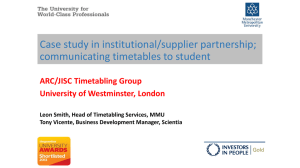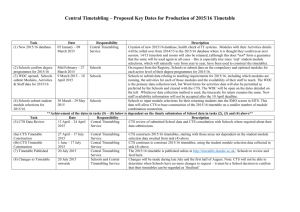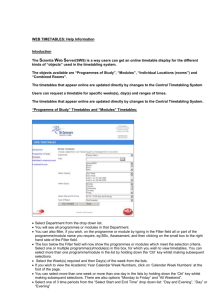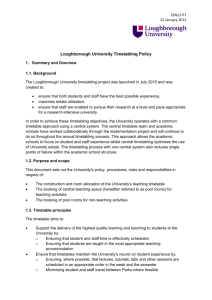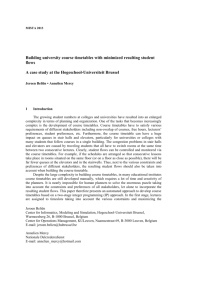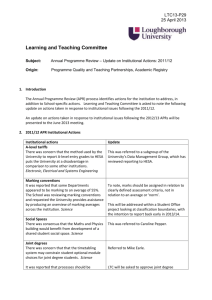Project Planning Document
advertisement
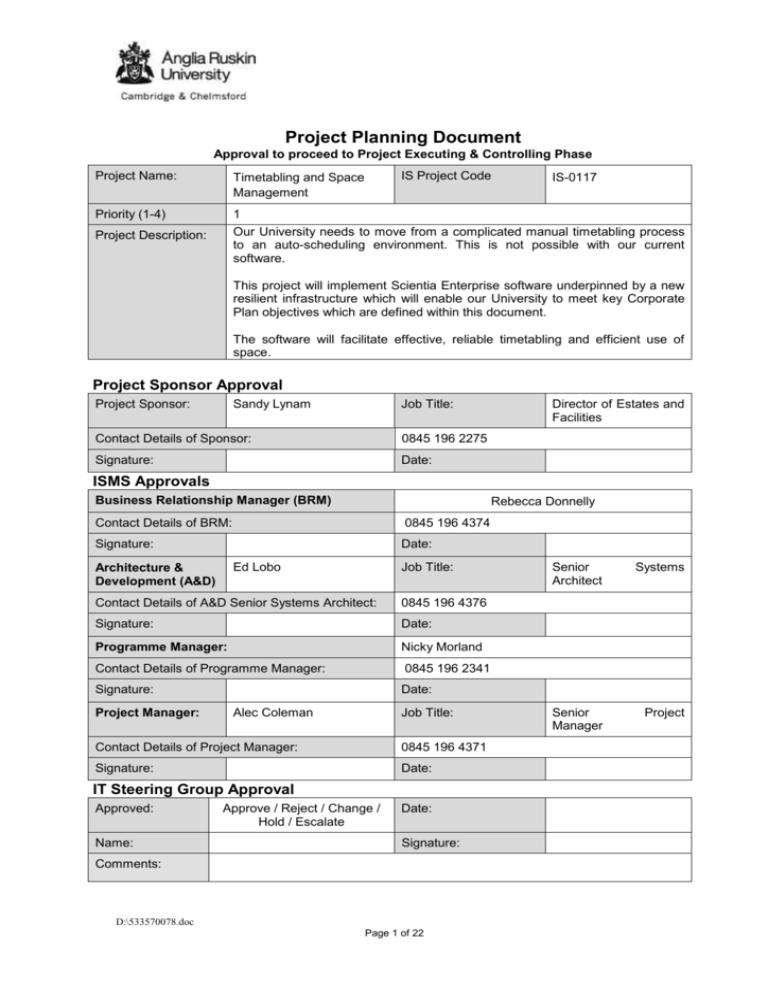
Project Planning Document Approval to proceed to Project Executing & Controlling Phase Project Name: Timetabling and Space Management Priority (1-4) 1 Our University needs to move from a complicated manual timetabling process to an auto-scheduling environment. This is not possible with our current software. Project Description: IS Project Code IS-0117 This project will implement Scientia Enterprise software underpinned by a new resilient infrastructure which will enable our University to meet key Corporate Plan objectives which are defined within this document. The software will facilitate effective, reliable timetabling and efficient use of space. Project Sponsor Approval Project Sponsor: Sandy Lynam Job Title: Contact Details of Sponsor: 0845 196 2275 Signature: Date: Director of Estates and Facilities ISMS Approvals Business Relationship Manager (BRM) Rebecca Donnelly Contact Details of BRM: 0845 196 4374 Signature: Date: Ed Lobo Architecture & Development (A&D) Job Title: Contact Details of A&D Senior Systems Architect: 0845 196 4376 Signature: Date: Programme Manager: Nicky Morland Contact Details of Programme Manager: 0845 196 2341 Signature: Date: Project Manager: Alec Coleman Job Title: Contact Details of Project Manager: 0845 196 4371 Signature: Date: IT Steering Group Approval Approved: Name: Approve / Reject / Change / Hold / Escalate Date: Signature: Comments: D:\533570078.doc Page 1 of 22 Senior Architect Systems Senior Manager Project Version Control Sheet - Change History Version Section Reason / Description Author Date 0.1 N/A First Issue Craig McAulay 9/2/09 0.2 N/A Initial revisions Craig McAulay 1/3/09 0.3 N/A Further revisions Alec Coleman / Craig McAulay 27/3/09 0.4 All Addition of Costs of hardware, Resources. Risks, Communications Plan, Milestones, Alec Coleman 24/4/09 0.5 All Amendments to deliverables and comments from Linda Parkes and Nicky Morland. Alec Coleman 30/4/09 0.6 All Update to costs and comments from Linda Parkes Alec Coleman 1/5/09 0.7 All Template version numbers removed at request of SL and costs amended. Alec Coleman 5/5/09 0.8 All Incorporating Kirsteen Williams comments Alec Coleman 6/5/09 0.9 Timescale Incorporating Martina Senft’s comments on contract award date Alec Coleman 7/5/09 1.0 Costs, Comms Plan and Risks Incorporating comments from Project Alec Coleman Board Meeting held 11/5/09 relating to capitalising Scientia software support and maintenance, risks and comms plan. 13/5/09 1.1 CSF’s Scope,secti on 7, Amendments from Nicky Morland 15/5/09 D:\533570078.doc Page 2 of 22 Alec Coleman Version 7: May 2009 1. Project Introduction and Background This Project Planning Document (PPD) is seeking approval to move this project to implementation of Scientia Enterprise, subject to successful piloting. As space becomes more restricted and our University offers pathways with more flexible teaching patterns, it is essential that Timetabling and Space Management Team can produce a timetable that maximises the use of space and allows room for income generation. With students as paying customers who have numerous commitments outside of their studies, it is also essential that timetabling information is accessible and available well in advance of the start of teaching. Our University needs to move from a manual timetabling process to an auto-scheduling environment. At present, the manual process means faculty timetablers each create their own faculty-specific ‘ideal’ timetable which is then presented to Timetabling & Rooming for amalgamation (where possible) with the other faculties’ timetables, prior to the timetable being roomed and events scheduled to students. T&R use two pieces of software to enable timetabling: CELCAT acts as a clash checker and a rooming/roombooking tool. The timetable is then replicated in SITS:Vision where students are scheduled to produce individual student timetables. For 2008/9, Timetabling & Rooming have successfully managed to produce timetables two months earlier than usual, but it is becoming increasingly apparent that CELCAT has not developed in line with our needs and is unlikely to do so for the foreseeable future, remaining essentially a visual tool to enable manual timetabling. The upgrade to SITS:Vision in November 2007 changed the scheduler functionality drastically and caused a number of problems - the latest in the long line of issues with scheduling functionality. The timetabling function of SITS is now unwieldy and consistently unreliable, and does not enable auto-scheduling. If our University is to progress timetabling any further and manage our use of space more effectively, we need to move towards automatically scheduling a whole campus timetable that takes into account the available roomstock from the outset, the teaching requirements, and creates a timetable that then makes best use of our resources. There are a number of software packages in use by other universities that achieve this, at the same time integrating effectively with estates software and allowing easy forecasting of future space needs Currently there is a large estate of teaching, specialist and general space, distributed over two main campuses. There is no way of accurately knowing how much space is actually utilised, for which purposes and by whom. Also there is no way of accurately knowing how much space is free and available for separate internal or external bookings. This project will directly impact and meet Corporate Objectives 1 and 9. 1) In ensuring that 9 out of 10 students would recommend us to a friend. The recent National Student Survey was critical of the timetabling experiences of our students. Our University must address and improve this through the successful implementation of a new timetabling system 9) We are recognised for successful innovation in the way in which services are provided and for imaginative new learning environments. This states ‘As a community we find timetabling difficult. Part of the problem has been that we do not have modern timetabling software.’ By December 2009:- have established streamlined timetabling processes and have identified and purchased new timetabling software. D:\533570078.doc Page 3 of 22 Version 7: May 2009 2. Summary of Business Case Our University needs to move from a manual timetabling process to an auto-scheduling environment; effectively this means ceasing to create individual faculty- and campus-specific timetables, and then assembling a patchwork which neither makes most effective use of our roomstock nor exactly matches the timetables presented to us by faculties. An auto-scheduling environment means all teaching requirements, and room information, are input into a software package, which then produces a timetable that makes best use of resource. Our University also needs to move towards a centrally held space management facility, which enables the accurate and timely management of space within our estate. This includes the ability to perform ‘what-if’ modelling, eg removing a set of rooms & recalculating & giving a range of solutions for the rerooming. Space Audits are also required; this would typically include the amount and frequency of room usage, along with a view of the capacity. None of the above is available with the current CELCAT/SITS solution. The project team has therefore investigated software packages and timetabling/rooming practices at other Institutions, in order to establish an appropriate business process and suitable software package that meets our University’s requirements for now and the future. The project is aiming to greatly increase the accessibility of space management information and would look to use a self service solution to achieve this. The following have been sourced from the Timetabling team and are in the ‘Proposed Solution T&R Doc(2)’:Problems /issues with SITS: The timetabling and rooming functions are not sufficiently reliable to be used as the single timetabling and rooming database. Major bugs have been present in every upgrade. The November 2007 upgrade drastically changed the timetabling and scheduling functionality, removing two key functions: the ability to print paper timetables and to record a breakdown of event content. No auto-scheduling facility to create timetable (at a SITS seminar in June 2008 we were advised that this was at the early planning stages) Processes to create timetabled events are extremely complicated and time consuming (consultancy day in summer 2007 confirmed that we are using the functionality correctly) Timetable view through e-vision is not user-friendly (NSS feedback) Timetabling print-outs and screen views are not user-friendly Problems/issues with CELCAT Cannot allocate students randomly to teaching events No auto-scheduling facility to create timetable (CELCAT advise this is in development) Acts as a visual aid to timetabling, clash checking is automated but no other functions are (e.g, cannot suggest times when a combination of resources are free) Web views are not user-friendly (NSS feedback) There is currently no data-feed between SITS & CELCAT so the timetable has to be manually created on both systems. CELCAT were asked to develop a data-feed but have so far not been able to do so. D:\533570078.doc Page 4 of 22 Version 7: May 2009 3. Benefits This project will ensure that our University is able to meet the following Corporate Objectives: 9 out of 10 students would recommend us to a friend. The recent National Student Survey was critical of the timetabling experiences of our students. We are recognised for successful innovation in the way in which services are provided and for imaginative new learning environments. This states ‘As a community we find timetabling difficult. Part of the problem has been that we do not have modern timetabling software.’ By December 2009:- have established streamlined timetabling processes and have identified and purchased new timetabling software. In addition the project will provide: A single shared system that allows faculty timetablers and TSM staff to share information electronically An easy to use system with views and reports that can be tailored to suit individual user requirements Simpler, automated timetabling processes Automated constraints-based scheduling ensuring that space is used effectively Elimination of duplicated tasks (currently faculty timetablers create timetables using their own systems and send the information to TSM to input manually into CELCAT. Once the timetable is complete on CELCAT, TSM staff manually recreates the whole timetable on SITS so that students can be scheduled. S+ will allow faculty timetablers and TSM staff to share information within the software and also has the capability to schedule students) The ability to model space and curriculum developments Staff timetables will be available on the web via a secured login. All university space is booked on a single system Accurate reporting of space utilisation Web-based room booking facility that will allow users to see what space is available prior to booking and track bookings and cancellations. Faster response to timetable changes (only one system to be updated, student/staff timetables will reflect changes instantly) Fair timetabling constraints for everyone (S+ enables hard constraints e.g., an hour free between 12.00 and 14.00 for all staff, one day a week free of teaching for all students) If accurate and complete timetabling information is provided at the required times, the system will facilitate earlier publication of timetables (students and staff will know their timetables well in advance and can plan accordingly, space for other events can be released earlier) 4. Critical Success Factors Improved student experience. Use questionnaire to obtain feedback. Implementation of the new hardware and software in accordance with agreed timeframes. Production of clash-free campus timetable that maximises space Production of staff and student timetables from a single source Production of a space management facility with autoschedule capability Delivery of web-based room-booking tool. Automated scheduling Automated processes for faculty staff and central timetablers Electronic exchange of information between faculty staff and central timetablers Effective integration with SITS The facility to set sophisticated constraints. A system that can be used University-wide for the booking of ALL space A system that enables effective reporting on space utlisation for audit and HESA purposes. D:\533570078.doc Page 5 of 22 Version 7: May 2009 Production of clash-free campus timetable that maximises efficiency in space utilisation Production of staff and student timetables from a single source User-friendly reports and timetables Timetables available via my.Anglia portal behind which is e-vision Facilitate space and curriculum planning Facilitate web-based room-booking 5. In Scope People: Timetabling Managers Timetabling staff Faculty Timetable Managers & staff Estates Managers & staff Academic staff Students. Creation of university timetable Scheduling and production of student timetables Checking for and resolution of timetable clashes Web-based room booking facility for University staff and students Allocation of rooms for teaching and one-off bookings Production of staff timetables (paper, electronic via my.Anglia Portal behind which is e-vision,) Creation of registers Reporting on space utilisation Room timetables Web view of general timetables (pathway, room, module) Student seminar changes Integration with Active Directory, my.Anglia portal/e-vision to be used to deploy link to Student Timetable Scientia Enterprise Scientia Database Syllabus Plus Data Adaptor Scientia Web server Web Room Booking Web Data Collection Space Utilisation Reports Optional module Processes: Systems: D:\533570078.doc Page 6 of 22 Version 7: May 2009 6. Out of Scope People: Those not specifically stated in 5 above. Processes: Systems: Exams scheduling Downloading of timetables into Outlook Staff workload planning Printing and completing of class registers Module Catalogue Student enrolments Student Module Changes Assessment generation Accuracy and timeliness of timetabling information provided by faculties Attendance Management Student ‘Self Select’ modules Pythagoras (potential replacement for existing Cad system used by E&FM)) Web-based room booking facility for people without an Anglia Ruskin staff/student login Any classroom hardware that shows attendance of students in classrooms, e.g. swipe card and readers and screen equipment. Scientia Optional Modules as follows: (other than the Space Utilisation module) Exam Scheduler; Exam Web server and Automation tools; Timetable Calendar Service, Staff Workload Planner. Other: D:\533570078.doc Page 7 of 22 Version 7: May 2009 7. Project Solution, Objectives and Deliverables Proposed Solution The Scientia Enterprise suite was selected as the preferred product at the end of the Timetabling and Space Management System OJEU Tender process in March 2009. The new software will be piloted with two faculties during 2009/10, running parallel with existing systems. After successful completion of the pilots, the new software will be used university-wide in 2010/11. Objectives The objectives that must be addressed by this project are: Optimise timetabling around student’s module choices and staff preferences. Streamline and automate the timetabling processes, avoiding duplication of tasks. Implement a robust system to aid the efficient use of space and staff resource Facilitate management of income generating activities through efficient space allocation Facilitate early production of timetables (2 months in advance) Facilitate establishment of web-based room booking system Facilitate accurate forecasts of future space requirements Enable consistency in room allocation for course delivery. Generation of an accurate space utilisation statistics for HEFCE Deliverables: Pre Planning Completed Business Analysis of the ‘as is’ and ‘to be’ Timetabling processes Completed and agreed Technical Architecture documents to support the new infrastructure Implementation Contract signed with Supplier Implementation of Scientia Enterprise in test environment for pre pilot Infrastructure installed in readiness for pre pilot Installed Live, Development, Test & Training systems to Tier 1 availability standards Implemented pilot ALSS and FHSC Fulbourn and Peterborough User Acceptance Test Plan User Acceptance Tested System Trained Users Timetable delivered via Scientia Enterprise D:\533570078.doc Page 8 of 22 Version 7: May 2009 Objective Deliverable PHASE 1 BUSINESS FEASIBILITY 7.1 Operational Acceptance Checklist to be agreed with Operations By (20/12/09) 7.1.1 Operational Acceptance Checklist prepared and confirmed. 7.2. Proceed with implementation of the new software. By (1/6/09) 7.2.1 Signed agreement with Scientia. 7.3. To provide the basic infrastructure to enable Timetabling Team to start to familiarise themselves with the new software. By (10/6/09): 7.3.1 A basic training system is available with Semester 1 data from Celcat 7.4. To have conducted the necessary, familiarisation, training and testing of timetabling data using the new Scientia system and ensure that the project is ready to move forward to the Pilot Phase 2. PHASE 2 By (30/7/09): 7.4.1, Agree business decisions on Data and Processes in readiness for Phase 2 Pilot 7.5. Phase 2 entails the implementation of the core system to enable a pilot of live data within ALSS and FHSC Peterborough and Fulbourn. It will involve in house training of timetablers for pilot users and installation of all Scientia products. PHASE 3 By (20/12/09): 7.5.1, Timetabling Team to be able to generate timetable for semester 2 for whole University using new software 7.6. Phase 3 entails the implementation of the final system to enable the entire timetabling process to be carried out using the Scientia products. By (1/03/10): 7.6.1 Timetabling Team to be able to generate timetable for semester 1 for whole University By (31/07/10): 7.7.1. Handover fully operational system into production use to Operations and Customer Support teams. 7.7. Phase 3 will result in a fully tested infrastructure that is able to meet the any pre-specified Tier 1 availability requirements where this is possible using the Scientia solution. CORE SYSTEM IMPLEMENTATION & PILOT ROLL OUT 8. Assumptions Financial There is funding available for the duration of the Project. Currently only £300K has been assigned from Hefce 5 funding. Additional funds are being sought from Capital Steering Group. Business The staff resources will be available as required. Technical The system conforms with our University’s technical strategy and that Tier 1 architecture design considerations as defined by Technical Architects. D:\533570078.doc Page 9 of 22 Version 7: May 2009 Timescales The Project will be delivered during the financial year ending July 2010. Skills Resources from the supplier will have the appropriate skills and experience for their role. Also, that we have adequate skills internally. Culture Our University’s staff will be amenable to changes in process Other 9. Other Options Considered Option 1) Stay with current supplier – this is not feasible as the current supplier has indicated that they will not be developing their product in the near future. There are significant function and data access issues that are restricting the effective use of this system. Option 2) Do nothing – this is not feasible as this would miss the opportunities offered by the range of fully featured, mature systems which are available. D:\533570078.doc Page 10 of 22 Version 7: May 2009 FORM – PPD Appendix B 10. Risks Risk No Risk Description Date raised Owner Impact Likelihood Mitigation Status Date reviewed 1 Level of Risk 1 1 Anglia Ruskin TSM staff availability 1/3/09 SL 1 Schedule resources as early as possible & monitor workload Open 9/4/09 2 Anglia Ruskin Faculty staff availability 8/4/09 DH/DF 3 2 6 Schedule resources as early as possible & monitor workload Open 9/4/09 3 Anglia Ruskin Architecture & Development staff availability (Ed/McRaymond) 1/3/09 GW / AC 2 2 4 Schedule resources as early as possible & monitor workload Open 9/4/09 8 Changes to SITS functionality during upgrades may compromise Syllabus Plus and affect timetabling 6/4/09 JT 1 1 1 Open 9/4/09 6/4/09 Project Board 3 3 9 Ensure testing for SITS upgrades encompasses Syllabus Plus. Linking with SDCT regarding dates of upgrades. Understand the timelines for the recode. Then decide least risk approach and implement as appropriate. ALSS/SDTC to confirm dates. Ensure that the pilot works around these dates. 9 The ALSS recode project is a dependency for the pilot of Scientia. We can work with old or new ALSS courses, modules and pathways but not a combination of both. The risk is of inconsistencies in the timetabling system. Open 9/4/09 D:\533570078.doc Page 11 of 22 Version October 2007 FORM – PPD Appendix B 10 Potential lack of senior management commitment 6/4/09 Project Board 2 2 4 Communicate with Senior Management Open 10/5/09 16 That expectations may be higher than that which is actually being delivered. 8/4/09 Project Board 2 2 4 Ensure that stakeholders are aware of what is being delivered. Being clear about what is being delivered by the project and what is not – e.g. Exams. Follow communications plan Open 10/5/09 11. Issues ` D:\533570078.doc Page 12 of 22 Version 7: May 2009 12. Costs Cost £497270 £26124 Capital Revenue P.A after year one * Other VAT £67810 £3919 Total £565080 £30043 Detailed costs are included at Appendix A * It should be noted that the Project Executive Board has requested that we capitalise the first three years of Scientia Maintenance and support into year 1 capital costs. However, this is subject to agreement by Finance. In the meantime, until such time as agreement is reached, the cost P.A. for year two onwards of Scientia Maintenance and support is shown in revenue. Tolerance: Projects which, during execution, exceed 10% of the original costs need to be referred to the Project Sponsor for agreement. 13. Staff Scheduling / Planning Estimated Total Days ISMS Architecture and Development Team ISMS Operations Team ISMS Projects Office ISMS Customer Support Team Finance Team Timetabling and Space Management Team Scientia 374 142 155 63 15 221 35 This is based upon a resource estimating programme developed by A&D team however the figures should be taken as estimates only. A detailed breakdown of the estimated resourcing requirements is available on request. Figures exclude stakeholders other than those identified. 14. Milestones (These milestones were discussed and agreed at meeting 27/8/09 in conjunction with Scientia) Milestone: Planned Date: Sign Contract 1/6/2009 Phase 1 - Business Feasibility: This includes the implementation of a training system on a basic training infrastructure using Celcat data and training users in TSM for familiarisation purposes. 30/7/2009 Phase 2 – Core System Implementation and Pilot: This involves outputs from Phase 1 to design system and install all Scientia software including SITS integration. After this phase TSM will be able to generate a timetable for Semester 2 for our entire University. 20/12/2010 D:\533570078.doc Page 13 of 22 Version October 2007 Phase 3 – Roll Out: This involves training of all staff, the design, install and test final infrastructure. TSM will be able to generate timetable for Semester 1 for our entire University. 1/3/2010 The architecture will be fully operational to Tier 1 standards. 31/7/2010 15. Project Organisation Executive Board Ajay Burlingham-Böhr Steve Bennett Derrik Ferney David Humber Sandy Lynam Helen Valentine (chair) In attendance: Alec Coleman Linda Parkes Kirsteen Williams Project Team Alec Coleman Sandy Lynam Linda Parkes Technical Ed Lobo McRaymond Unamma Applications Architect Business Process Will Burdett Kirsteen Williams (TSM Team) Communications Sandy Lynam Linda Parkes Kirsteen Williams Senior Supplier Kim Moulding Steering Group Alec Coleman Sandy Lynam (Chair) Shaun Le Boutillier and Geri Wren (ALSS) Anne Devlin (H&SC) D:\533570078.doc Page 14 of 22 Version 7: May 2009 Nicky Morland Linda Parkes Kirsteen Williams Les James (S&T) Chris Curran (Education) Josie Lloyd (AIBS) Central Services Students Union 16. Communications Plan See Appendix B – Communications Plan 17. Sign Off Approvals Sandy Lynam Project Sponsor Nicky Morland. Assistant Director – Programme Management Alec Coleman Project Manager Ed Lobo Senior Systems Architect – Architecture and Development Kirsteen Williams Senior User Alistair McCartney Assistant Director (Operations) Joe McIntyre (Customer Support) – or nominee 18. Comments The Capital costs relating to this Project are to be funded by Hefce5 of which £300K has already been agreed by CSG. A request for an additional £265K was submitted by Nicky Morland on 1/5/09. A decision is awaited as to whether we can capitalise the Scientia software maintenance and support charges for three years. D:\533570078.doc Page 15 of 22 Version 7: May 2009 Appendix A - Costings List of Modules Product - Core Scientia Enterprise SDB (Scientia database) RDBMS licence not included Automation tools – COM & Agents SPDA (Syllabus Plus Data Adaptor) Scientia Web Server Web Room Booking Web Data Collection Product - Optional CAPITAL CORE MODULES All Modules - Core Annual Maintenance and Support at £17,020 P.A ** Training & Consultancy (35 days) Additional Training & Consultancy Contingency - 5 days at £950 Per day Business Analysis (80 days McRaymond) CAPITAL OPTIONAL MODULES Space Utilisation Reports Annual Maintenance and Support at £1,500 P.A ** Training & Consultancy (1 day) Integration consultancy from 3rd party systems, e.g. Tribal (10 days est.) Staff Backfill (LP staffing doc) Scale 5 Contract Infrastructure Architect for 18 months at £3252 P.M (Includes Pension and NI) Estates charge - oncosts at £471.5 PM x 18 months * Server Hardware (est.) Server Software licencing SQL, VMware, MS DataCentre (est.) SAN storage (est.) LAN Equipment at Cambridge (est.) Upgraded PC's (7) for timetabling staff at £550 each TOTAL Contingency (10%) TOTAL Inc contingency VAT (15%) TOTAL INC VAT GRAND TOTAL D:\533570078.doc Space utilisation reports 85100 17020 30950 7500 1500 950 4750 28560 10000 64605 58536 8487 54600 28656 30000 17000 3850 442114 44211 486325 66317 552643 552643 Page 16 of 22 TOTAL Contingency (10%) TOTAL Inc contingency VAT (15%) TOTAL INC VAT GRAND TOTAL 9950 995 10945 1493 12438 12438 Version 7: May 2009 REVENUE AFTER YEAR 1 Annual Scientia Licensing & Support ** MS SQL and Windows Data Centre 2008 Software licensing TOTAL VAT (15%) TOTAL INC VAT 17020 REVENUE AFTER YEAR 1 Annual Scientia Licensing & Support ** 1500 7604 24624 3694 28318 TOTAL VAT (15%) TOTAL INC VAT 0 1500 225 1725 TOTAL CAPITAL FOR CORE & OPTIONAL £565,080 TOTAL REVENUE FOR CORE & OPTIONAL £30,043 * Note There will be a cost after three years for server hardware support. ** Project Executive Board have requested that the first 3 years of Scientia Support and Maintenance are capitalised - a decision is awaited from Finance as to whether this is possible before this can be reflected in above figures. D:\533570078.doc Page 17 of 22 Version 7: May 2009 FORM – PPD Appendix B Appendix B – Communications Plan Audience Purpose of communication To engage with audience and bring onside with project Main Messages Business Relationship Managers To explain the project timescales and deliverables To encourage them to spread the message to users ITSG To explain the project timescales and deliverables To communicate changes at a high level CMT VCG and What we expect from them To ensure that all staff are fully engaged with the importance of this project. Full interaction with presentations Take the message forward to their staff. How do we communicate? Monthly reports to CMT from LP. Presentation/roadshow by Linda and Kirsteen When? That the project will be going through the OJEU procurement process & then will be piloting All space is within scope There will be a University wide Timetable To raise any concerns To spread the message to other users Telephone & email and face to face Monthly reports Monthly The project involves the selection, piloting & implementation of new software and all staff and students will be affected. The project will bring timetable benefits to all staff & students How the project fits into the corporate plan How the project supports other ISMS projects The project timescales To raise any concerns over timescales and changes To advise the project of anything else we might need Approval of the PPD Project Planning Document (PPD) to be presented to ITSG At end of Planning Phase, May 2009 Background to project Objectives Benefits Approach Timescale Pilots D:\533570078.doc Page 18 of 22 Version October 2007 Monthly FORM – PPD Appendix B Audience Purpose of communication To engage with audience and bring onside with project To ensure that staff are aware of the need to adapt their working practices and business processes To ensure the quality and timeliness of data To ensure that staff are involved Main Messages Timetable Working Group To explain objectives of project To explain the project timescales and deliverables Business as usual e-Admin To explain objectives of project To explain the project timescales and deliverables Heads of Depts and Faculty timetablers D:\533570078.doc What we expect from them To sell the importance of this project to all staff Full interaction with presentations Take the message forward to their departments Commitment of staff resources How do we communicate? Presentation/roadshow by Linda and Kirsteen CMT status reports – Kirsteen to send status reports to faculty timetabling. (Monthly) Via the Project Team project governance arrangements. Monthly Reports – Kirsteen to amend monthly report to ensure that they are fit for audience and then circulated. When? How the project will impact on the Faculties timetablers Benefits to Faculty timetablers Input required from Faculty timetablers To ensure business as usual Regular brief project updates to TWG (TWG to be replaced by Project Steering group as the communications audience) Monthly How the project will impact all stakeholders To review objectives and examine dependencies with any other initiatives, either planned or underway Regular updates to eAdmin in the form of monthly project status reports Aligned with eAdmin meeting schedule Background to project Objectives Benefits Approach Timescale Pilots Page 19 of 22 Version 7: May 2009 As required. Plan to coincide with Faculty meetings Reports Monthly FORM – PPD Appendix B Audience Project Team Staff – Timetabling &, Space Management D:\533570078.doc Purpose of communication Purpose of project Scope Benefits Timescales Work packages Main Messages To ensure that they are engaged with the pilot process Raise awareness of project benefits, scope & timescale The supplier will be providing appropriate training and support The project team will create draft procedures for their pilot tasks What the project will mean to them How the timetabling & space management information will be accessible in the future What their role in the project is Which work/output is required of each project team member Page 20 of 22 What we expect from them Full engagement in the project To raise queries and ask for assistance at the first opportunity To undertake training as planned To identify any conflicts with nonproject work How do we communicate? Training by supplier/lead user Project team & member meetings Telephone and email reminders Project Status Reports When? To understand the tasks and create detailed work instructions To be able to support and help with the pilot To raise and help to resolve any issues before live Full engagement in the project To raise queries and ask for assistance at the first opportunity To undertake training Face to face / Email and telephone with key staff Demonstration of tools and draft work instructions Training by lead user Meetings with all staff Telephone & email reminders Weekly Meetings Version 7: May 2009 Scheduled weekly / 2 weekly meetings FORM – PPD Appendix B Audience Purpose of communication To ensure that they understand what is required and are able to perform their pilot tasks To ensure that there are no conflicts with the existing timetable process Main Messages Support Staff ISMS, Architecture & Development ,Operations & Customer Support Gain understanding of technical requirements All Staff To avoid any surprises To minimise disruption associated with the changes To reduce the number of support calls generated by the changes To encourage staff to be positive about the changes To avoid any Pilot Faculties and TSM Staff All Students D:\533570078.doc What we expect from them To undertake training To raise queries and ask for assistance at the first opportunity To familiarise themselves with the new software To work with us to resolve any conflicts How do we communicate? Training by supplier/lead user Telephone and email reminders Meetings with appropriate pilot staff Demos and testing with pilot staff When? What is required to deliver the technical installation & access for this project What is required to integrate the data & apply Web Services with any other systems Early raising of queries Adherence to schedule Commitment of resources with appropriate skills Meetings with supplier & document reviews Email & telephone reminders Weekly project meetings We are making changes to the timetabling solution This will assist with improving the accuracy & availability of the timetable information We are making the changes to improve the staff & student user experience The project timescales To raise any concerns To be prepared for the changes To understand who to contact for support and when to do this, and when to use the online support Monthly report to HOD for cascading to staff. Update pages on ANET. Staff road shows Printed fliers showing key points and links to support pages and who to contact Monthly updates bulletin We are changing the timetable To be prepared for All students email Post Pilot The purpose of the pilot is to establish how to use the new software to build the new timetable This is a learning exercise and there will be appropriate support available throughout The existing system (CELCAT) will be used to produce the live timetable in parallel, while the pilot is undertaken. Page 21 of 22 Version 7: May 2009 Weekly Project Meetings FORM – PPD Appendix B Audience Capital Projects Steering Group D:\533570078.doc Purpose of communication surprises To minimise disruption associated with the changes To reduce the number of support calls generated by the changes To encourage students to be positive about the changes To ensure they are aware of the need for funding Main Messages delivery and adding more features The timetable will still be available via SITS eVision (Although it is recognised that the future aim will be to give consistent access via the Portal) That the project is high priority/importance Page 22 of 22 What we expect from them the changes To understand who to contact for support and when to do this, and when to use the online support How do we communicate? Information screens Update pages on ANET Printed fliers showing key points and links to support pages and who to contact When? Confirmation of funding agreement Project updates Monthly report copied to attendees Version 7: May 2009
